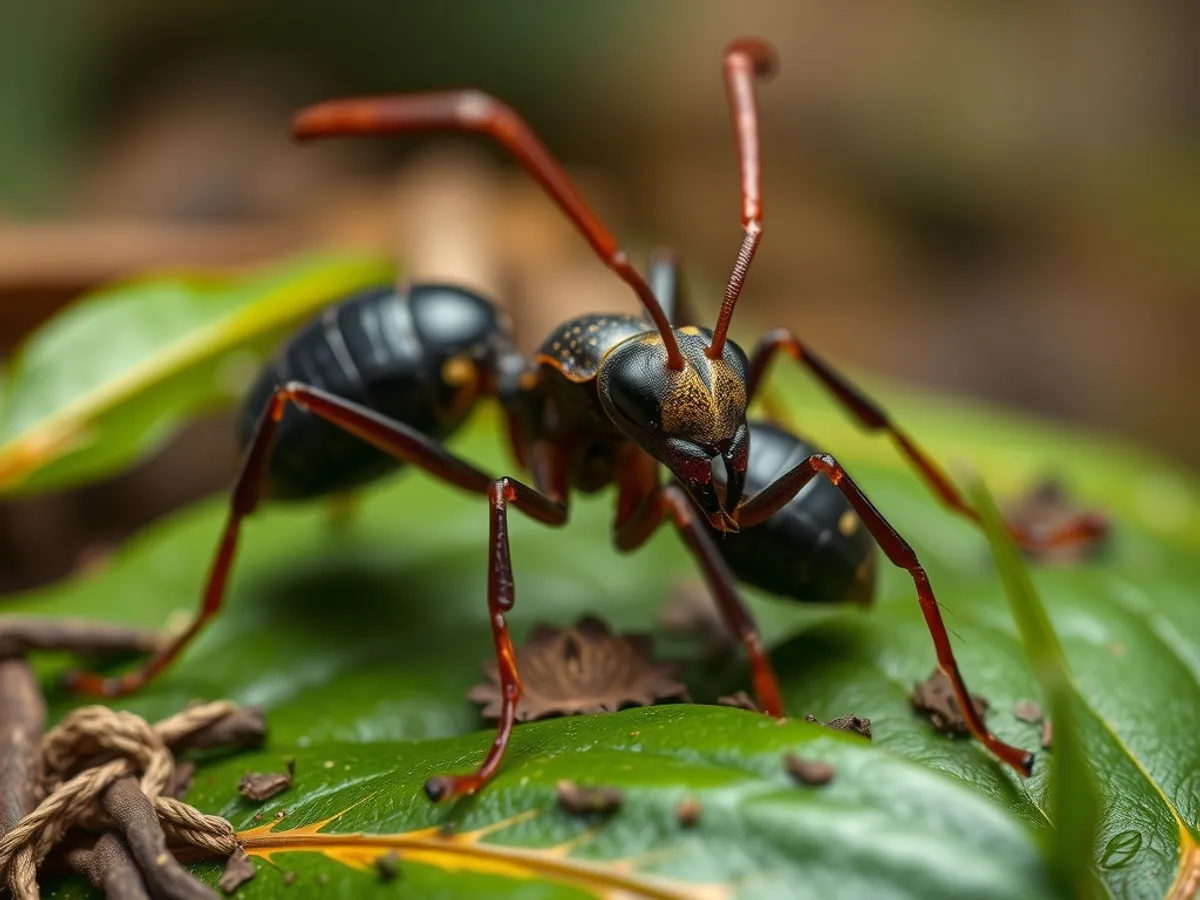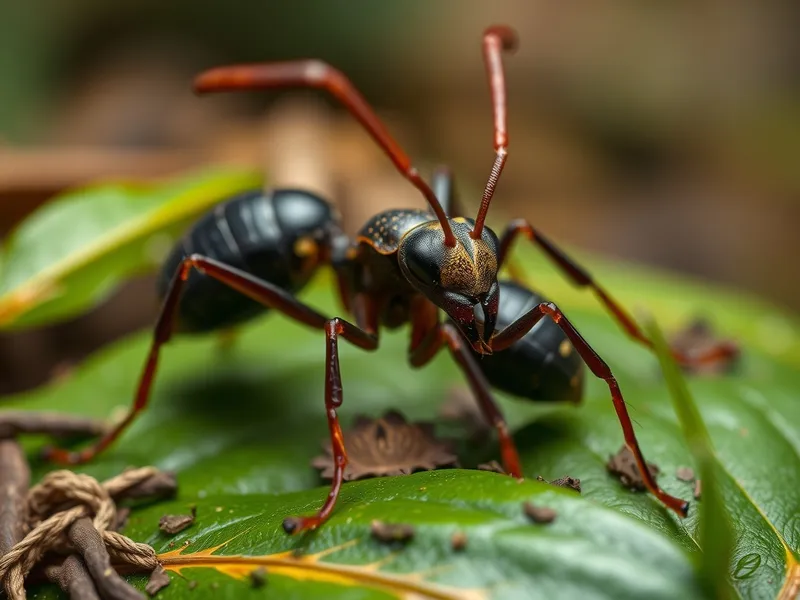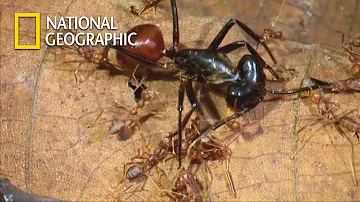
Giant Forest Ant
Camponotus gigas

Meet the Giant Forest Ant
The Giant Forest Ant is one of the largest ant species in the world, with workers reaching impressive sizes. Native to the rainforests of Southeast Asia, these ants are known for their black or dark brown bodies and robust mandibles. They live in complex colonies that nest in decaying wood or underground, with a clear social structure. Despite their daunting size, they are generally non-aggressive and play an important ecological role in the forest ecosystem.
Classification
Invertebrate
Habitat
Tropical rainforest
Diet
Omnivore
Lifespan
1-2 years (workers), up to 5 years (queen)
Conservation
Least Concern
Weight
0.2–0.5 grams
📖Fascinating Facts
Gigantic Size
Workers of the Giant Forest Ant can grow up to 28–30 mm, making them some of the largest ants in the world.
Rainforest Dwellers
They are primarily found in the dense, humid rainforests of Southeast Asia, especially Malaysia and Indonesia.
Multiple Queens
Giant Forest Ant colonies often contain several queens, which helps the colony grow and thrive.
📋Detailed Description
The Giant Forest Ant (Camponotus gigas) is the largest ant species in Southeast Asia and among the largest ants globally, with major workers (soldiers) reaching lengths up to 28 mm and queens exceeding 30 mm. Their bodies are robust, glossy, and predominantly dark brown to black, with reddish hues on the legs and mandibles. The species exhibits pronounced polymorphism, with distinct castes including minor workers, major workers, and a single reproductive queen per colony. Their powerful mandibles are adapted for both defense and processing a wide range of food sources. Colonies are typically found in the lowland and hill dipterocarp forests, nesting in decaying logs, tree stumps, or occasionally underground, and can contain thousands of individuals. Camponotus gigas is primarily nocturnal, with foraging trails extending up to 50 meters from the nest, and workers communicate via chemical pheromones and tactile signals. The ants are omnivorous, feeding on honeydew from sap-sucking insects, plant exudates, and a variety of arthropods. The species plays a significant ecological role as both predator and scavenger, contributing to nutrient cycling and seed dispersal. Despite their intimidating size, they are generally non-aggressive toward humans and other large animals, relying on their size and chemical defenses for protection.
💡 Did you know?
Despite their size and formidable appearance, Giant Forest Ants rarely bite humans and use their size primarily for defense against predators.
🔬Research & Sources
🎭Behavior & Social Structure
Giant Forest Ants are primarily nocturnal foragers, with peak activity occurring after dusk and before dawn. Workers establish well-defined foraging trails, which can extend up to 50 meters from the nest, and are maintained by pheromone marking. Their diet is highly opportunistic; they tend honeydew-producing insects such as scale insects and aphids, harvest plant exudates, and scavenge or hunt small arthropods. Social interactions within the colony are highly organized, with distinct roles for minor and major workers. Majors typically defend the nest and clear foraging paths, while minors focus on food collection and brood care. Aggression is mostly reserved for interspecific competition or nest defense, and intraspecific conflicts are rare due to strong colony cohesion. Daily routines involve cleaning, brood tending, and nest maintenance, with workers often observed grooming each other and the queen. Communication is primarily chemical, but tactile signals are also important during cooperative tasks such as transporting large food items.
👶Reproduction & Life Cycle
Reproduction in Camponotus gigas follows the typical ant pattern of a single reproductive queen per colony. Nuptial flights occur at the onset of the rainy season, usually between March and May, when winged males and virgin queens leave the nest to mate. After mating, queens shed their wings and seek suitable nesting sites in decaying wood or soil. The queen lays her first batch of eggs, which she tends alone until the first workers emerge. Development from egg to adult takes approximately 6-8 weeks, depending on temperature and humidity. Once the first generation of workers matures, they assume colony maintenance and foraging duties, allowing the queen to focus solely on egg-laying. Parental care is provided by the workers, who feed and groom the larvae. Colonies are long-lived, with queens surviving for several years and colonies persisting for decades under stable conditions.
🛡️Adaptations & Survival
Camponotus gigas exhibits several adaptations for survival in dense tropical forests. Their large size and strong mandibles deter many predators and enable them to process tough food sources. The species' nocturnal activity reduces competition with diurnal ants and minimizes predation risk from birds and other visual hunters. Their cuticle is thick and waxy, providing protection against desiccation and fungal pathogens prevalent in humid environments. Behavioral adaptations include the use of pheromone trails for efficient foraging and recruitment, as well as cooperative transport of large prey items. Polymorphism within the worker caste allows division of labor, optimizing colony efficiency. Their mutualistic relationships with sap-sucking insects provide a reliable carbohydrate source, while their omnivorous diet ensures flexibility in changing environments.
📚Research Sources
🎨Cultural Significance
While Camponotus gigas does not have a prominent role in regional mythology or folklore, its impressive size and striking appearance have made it a subject of curiosity among naturalists and local communities. In some indigenous cultures, large ants are regarded as symbols of strength and cooperation, though specific references to C. gigas are rare. The species is occasionally featured in educational programs and ecotourism activities highlighting rainforest biodiversity. There are no known traditional uses of this species in medicine or cuisine.
🔬Recent Research & Discoveries
Recent research on Camponotus gigas has focused on its foraging ecology, trail organization, and the chemical composition of its pheromones. Studies have revealed sophisticated recruitment strategies and division of labor, with majors and minors exhibiting task specialization. Molecular phylogenetic analyses have clarified its relationship within the Camponotus genus, supporting its status as a distinct species complex. Ongoing research investigates its role in forest nutrient cycling and interactions with mutualistic insects. Notably, a 2021 study documented the species' resilience to habitat fragmentation, suggesting behavioral plasticity in disturbed landscapes. Further investigation into its microbiome and resistance to pathogens is underway, given its potential as a model for studying ant-fungal interactions.
🎥Wildlife Videos

David Attenborough Presents: Ant Mountain | Free Documentary Nature
David Attenborough's Ant Mountain | Wildlife Documentary Watch 'David Attenborough presents: Wild City Singapore' here: ...
Free Documentary - Nature

Killer Ants of Amazon Forest- Wildlife Documentary
This documentary is about the unknown social lives of the army ants. Known as the most feared animals in the equatorial forests ...
Living Attractions

A Giant Forest Ant (Dinomyrmex gigas) Worker Foraging in Bukit Timah Nature Reserve
Malaysian giant forest ant (Dinomyrmex gigas) is a central place forager which has a polydomous colony structure, and combines ...
Nature Documentaries

Army Ants Rampage Through The Forest | The Hunt | BBC Earth
Boasting a sensory system of 2 million antennae, this colony of Army Ants are a formidable proposition for anything alive which ...
BBC Earth

Army Ants Eat Everything | World's Deadliest
#NatGeoWILD #Ants #WorldsDeadliest About World's Deadliest: World's Deadliest Predators is a new series that looks at most ...
Nat Geo Animals

Chemical War of Ant Troops VS. One Goliath Ant|National Geographic
Camponotus gigas, a giant ant thought he will easily beat this small Weaver ant. But, the weaver ant was not alone and the ...
National Geographic Korea - English ver.
🌍Habitat Information
The Giant Forest Ant typically inhabits Tropical rainforest environments. Giant Forest Ants have adapted to their environments with specialized features and behaviors.
Primary Habitat:
Tropical rainforest
More detailed habitat information will be available soon.
🛡️Conservation Status
The Giant Forest Ant is currently classified as Least Concern. Conservation efforts are crucial for preserving this species for future generations.
Common Threats:
- 🏠Habitat loss and fragmentation
- 🌡️Climate change impacts
- 🎯Hunting and poaching
- 🏭Human-wildlife conflict
⚠️Threats & Conservation Challenges
Currently assessed as Least Concern, Camponotus gigas faces localized threats from habitat loss due to deforestation, logging, and agricultural expansion in Southeast Asia. Fragmentation of forest habitats can isolate colonies and reduce genetic diversity. Pesticide use in surrounding agricultural areas may also impact populations indirectly. However, the species' adaptability and broad diet contribute to its resilience. Climate change poses a potential long-term threat by altering forest structure and microclimates. Despite these challenges, population trends remain stable in large, undisturbed forest reserves, and the species is not currently targeted by the pet trade or commercial exploitation.
🔬Scientific Classification
Scientific Name
Camponotus gigas
Classification Hierarchy
🔍 About Taxonomic Classification
Taxonomic classification is a hierarchical system used by scientists to classify and organize living organisms based on shared characteristics and evolutionary relationships.
The system moves from broad categories (Kingdom) to increasingly specific ones, with each animal's scientific name typically consisting of its Genus and species.
📝Community Notes
Share your observations and insights about the Giant Forest Ant with our community of wildlife enthusiasts.
Join Our Community
Sign in to share your observations and connect with fellow wildlife enthusiasts.
Sign In to ContributeNo community notes yet
Be the first to share your observations about the Giant Forest Ant!
Explore Giant Forest Ant
Select a tab above to learn more about this amazing animal.
📸Photo Gallery
No photos available for this animal yet.
🌟Discover More Wildlife
Continue your journey of discovery with more fascinating animals from our database
